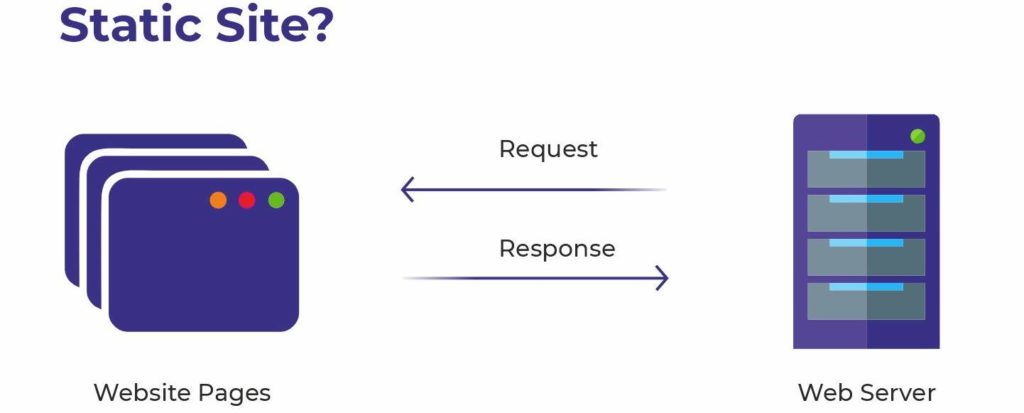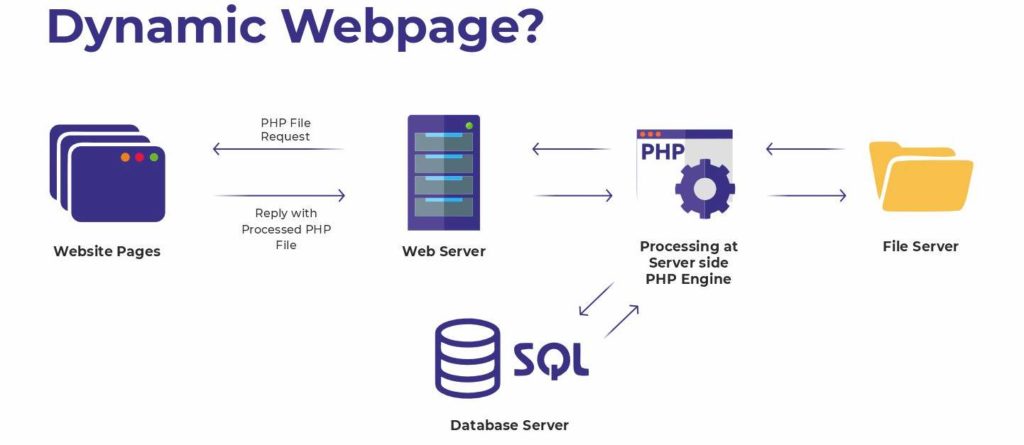A website is a group of linked web pages that could include text, images, audio, and video. A website’s home page is its initial page. You must enter a website’s specific URL into your browser to access it.
One or more servers host a website, which can be accessed by going to its home page via a computer network. An individual, business, or other entity can own and operate a website.
There are two types of websites:
What Is a Static Website?

A static website is one that uses pre-made, uploaded content that is fixed and waiting to be requested by a user’s browser. When a browser requests a page, the server responds with a page built using pre-written HTML, occasionally along with CSS and JavaScript.
Based on the HTML and other code, the browser then shows the page. Every user sees the same page when using static pages. The static website method works well for websites that don’t change all that often or can show the same pages to every user.
Websites for businesses, blogs, and other informational sites might be static.
Advantages of static websites
- Simple to create: Compared to dynamic websites, static websites are easier to use.
- Less expensive to build and host: Static websites are simpler, so building and hosting them are frequently less expensive.
- Flexibility: Because each page is built in advance, it is frequently simpler to change elements from page to page or use entirely different designs on various pages.
- Fast load time: Because the pages are already created, static websites typically load quickly.
- Secure: Static websites are frequently more secure.
- Simpler SEO: Search engines find it simpler to rank static websites because they typically load quicker.
- Cost Effective: Building static websites is less expensive.
Disadvantages of static websites
- Updates require more manual work: Static websites have the drawback of requiring more manual work to update your pages.
- Harder to scale due to manual updates: Though there are many tools that can assist with this, manually updating your pages makes scaling your site more difficult.
What Is a Dynamic Website?

Dynamic websites use server-side processing to generate pages instantly when a browser requests one. The exact HTML file that you uploaded to your server does not determine the webpage that a user views.
Instead, the website pulls information from a data source, loads it into a template, and then immediately generates HTML code. The dynamic approach is effective when you want to show each user a different page on a website with frequently updated content. Users can log in and access their personal profiles on dynamic websites, which include social media and e-commerce platforms.
The web developer did not hard-code the profile page for each user. Instead, these pages are created instantly by the website using the information a user entered to create their account.
Advantages of dynamic websites
- Allows for user login: Dynamic websites could be useful for allowing visitors to log in. You can generate pages, like user profile pages, dynamically based on the information from their accounts.
- Good for personalization: Personalizing content on dynamic websites is especially effective. If your website depends heavily on customization, dynamic might be your best bet.
- Good for frequent updates: If you frequently update your website, use the dynamic approach to avoid some of the manual work needed to update static pages.
- Scalability: A dynamic website can frequently be scaled more easily than a static one.
Disadvantages of dynamic websites
- More complex to build: Building dynamic websites can be more difficult because they are more complex than static websites. Along with the languages required for server-side processing, you’ll need to be familiar with HTML, CSS, and JavaScript.
- Can be more expensive to build and host: Dynamic sites can cost more to build and host than static sites because they are more complex.
Difference Between Static and Dynamic Websites:
| Static Website | Dynamic Website |
| Web page content cannot be altered in real time. | Web page content can change in real time. |
| No access to the database is possible. | It is possible to interact with databases. |
| In comparison to dynamic websites, it loads more quickly. | It is slower than a static website. |
| Lower development expenses. | Higher development costs. |
| There is no content management feature. | Features of a content management system can be present. |
| The website was developed using HTML, CSS, and Javascript. | PHP and Node.js are some server-side languages. |
| Each time the page loads, the same content is presented. | Every time a page is loaded, the content may change. |

